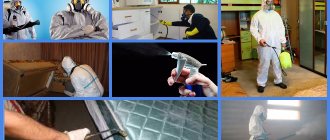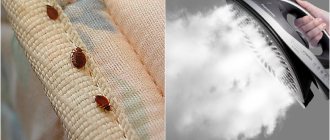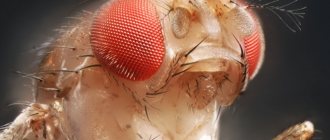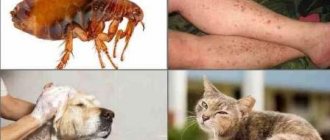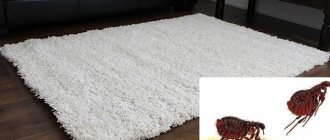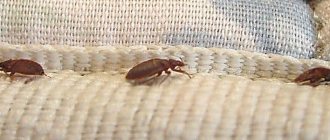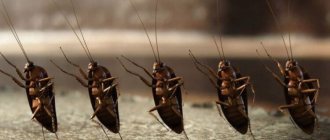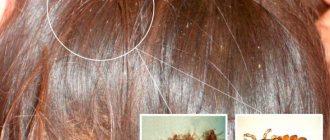It is impossible not to notice large insect pests on the site. All gardeners know by sight the mole cricket, Colorado and May beetles, white butterflies, click beetle and its wireworm larva, etc. They know, they are afraid, they take preventive measures against their appearance and, in the event of an “attack,” they use the appropriate means of struggle, the names of which they remember by heart.
But sometimes they don’t pay any attention at all to every winged six-legged little thing a couple of millimeters long, cheerfully jumping around the beds - well, how much will that little one eat, even if it encroaches on lovingly grown vegetables! And they don’t pay attention in vain.
Among garden pests, flea beetles occupy an “honorable” place, one of the main ones - and all thanks to their cosmopolitanism (they live almost everywhere), huge number and diversity (several hundred species in Russia alone), a wide range of damaged crops and... invisibility.
Who are these terrible pests, what garden crops are threatened and how to deal with them?
Ground fleas and methods of combating them
There are times when fleas appear in old houses or apartments, which cause huge troubles for the owners. They are brought in from entrances, basements and from neighbors. Ground fleas are small bugs from 2 mm, so individual insects are very difficult to detect. When they enter an apartment, they settle in baseboards, upholstered furniture, carpet paths and other places, lay eggs and reproduce. We notice their existence in our home and sound the alarm only after numerous bites, which are quite painful and take much longer to heal than mosquito bites. In addition, earth fleas can be carriers of diseases such as typhoid, plague, hepatitis B and C and many others.
Therefore, for those who have not yet encountered this problem, it is proposed to check and determine whether there are earthen fleas in your apartment. What is the best way to detect them? This can be done using plain white paper, which must be laid out in places most favorable for the existence of fleas. After 15 minutes, carefully examine the sheets. If small dark dots are found on them, which disappear after moving the paper, these are fleas.
Along with earth fleas, there may also be grass fleas in the apartment. This species has nothing to do with those insects that have the status of “warm-blooded”. Like all representatives of this species, they are tiny in size and differ only in color. They do not bite humans and are completely harmless to them. The main food of these fleas is plants. Therefore, you can easily guess that when you get into an apartment, indoor plants become their secluded habitat, which soon die.
How to kill fleas in your home? The first step is to wet clean the apartment with any detergent, wash all things, and preferably boil the bed linen. It is recommended to vacuum carpets, rugs and upholstered furniture, and if you have a steam generator, treat them with it.
The next stage of the fight is to treat the apartment using any flea remedy. This can be either regular Dichlorvos or more professional preparations such as Biorin, Efficient Ultra, Chlorpirimark and others. The packaging should bear the inscription “to combat crawling insects.” Here you can read detailed instructions for using this drug. The resulting solution is carefully treated with the baseboards, floor and walls of the room (1.5 meters from the floor). Any untreated surface gives these small insects a chance to survive.
After treatment, you must close the room for two hours. After which it must be thoroughly ventilated. It is not recommended to clean the treated apartment during the week. This is necessary so that not only earth fleas die, but also their larvae. If after a three-week period the insects have not disappeared, the procedure must be repeated.
When using any flea remedy, you must take maximum precautions: rubber gloves, gauze bandage. When choosing a product, you need to remember that organochlorine compounds can accumulate on the body of people, and this can lead to intoxication of the body. It is better not to use organophosphorus compounds and carbonates in residential areas, as they have a strong toxic effect. Less toxic agents include pyrethrum and pyrethroid.
To expel fleas from an apartment, you can also use folk remedies that are safe for residents. For example, fleas cannot tolerate the smell of herbs such as tansy and wormwood. They can be placed around the apartment in bunches, or you can use an infusion of these herbs for wet cleaning. After some time, all the fleas will leave your apartment on their own.
fb.ru
Flea bites: what they look like, why they are dangerous, treatment
Unlike other blood-sucking human ectoparasites - ticks or bedbugs - it is impossible not to notice contact with a flea. Each injury to the skin is accompanied by acute burning pain, akin to an injection. Earth fleas do not care about the comfort of their host. They are not afraid to discover themselves, because catching and destroying an insect with bare hands is not an easy task.
The only way to mechanically kill a flea is to press it with your finger onto a hard surface and crush it.
Favorite areas to attack are the legs from the feet to the knees. With the first portion of saliva, anticoagulants are injected - substances that prevent blood clotting - and a stream of blood flows like a fountain into the parasite. During the feeding process, bowel movements occur. At the site of the bite, a small tubercle with a hole forms, when damaged, inflammation and suppuration occur: therefore, it is recommended to refrain from scratching. Upon careful examination of the affected area, blood crusts are noticeable, and minor bleeding is possible. Another evidence that the bites came from fleas is the presence of several punctures in a small area of the skin.
Characteristic flea bites are small red bumps with bloody crusts.
The danger of flea bites
The damage done to the body is directly proportional to the number of attacks. And if two or three bites cause only local discomfort, then a series of attacks will not go unnoticed by the body. After all, fleas are carriers of deadly diseases and various helminthic infestations. They themselves call:
- pulicosis is a dermatological disease characterized by deep damage to the skin, lymphatic and nervous systems; the bite area itches, swells and thickens, and ulcers appear on the mucous membranes;
The name pulicosis comes from the Latin Pulex irritans (human flea) - Tungiasis (sarcopsillosis) - its causative agent - a sand flea - penetrates under the skin and sticks to a blood vessel, and at the site of attachment a large infiltrate is formed, which becomes a source of excruciating itching and pain, the affected area begins to peel off, swells greatly, and turns red.
In Uganda in 2010, a sarcopsillosis epidemic affected 20 thousand people, 20 of whom died
Due to scratching of the bite sites, foci of secondary infection occur. Insects often become a source of allergic reactions. Fleas are especially dangerous for children, who are more susceptible to complications.
Video: flea attack on children
Allergy
This is an unusual immune system response that occurs due to contact with insect saliva. People with reduced sensitivity to flea secretions do not show signs of general deterioration in health. A burning sensation and itching appear at the puncture site, and a papule (intradermal nodule) forms. Typical reactions include swelling and slight redness. After 2–3 days, healing occurs.
Allergic reactions to flea bites often occur in children
Some people have an atypical response (even anaphylactic shock) to a flea bite. It is extremely important not to ignore the symptoms and respond adequately to their appearance - seek medical help in a timely manner.
Symptoms of an allergic reaction:
- high temperature, chills;
- painful, almost unbearable itching at the bite sites;
- significant swelling and redness of the skin;
- active blood supply (hyperemia) of papules, formation of abscesses;
- swollen lymph nodes;
- neuroses.
In rare cases, the following occurs:
- difficulty breathing, suffocation;
- headaches, dizziness, loss of orientation;
- dysfunction of the gastrointestinal tract;
- pressure surges.
Treatment is carried out with antihistamines, antipyretics and sedatives.
Inflammation
It appears often and is usually a sign of an allergic reaction; the lack of treatment in this case is fraught with serious consequences for the entire body. The appearance of swelling, suppuration and extensive redness indicates the presence of infection in the wound. In any case, seek medical help immediately, as self-medication will worsen the situation. Symptoms of inflammation are:
- increased swelling;
- the appearance of pus (purulent crusts);
- increasing itching;
- soreness;
- redness of a large area around the bite site.
Inflammation of flea bites with suppuration and swelling is a reason to consult a doctor
Diseases transmitted through a bite
In the Middle Ages, it was these bloodsucking creatures that caused the bubonic plague epidemic, which claimed thousands of lives. Lack of treatment and ignoring bites increases the risk of infection. Fleas are the cause of neuroses and insomnia, carriers of various viruses, bacteria, fungi, and worms. The most dangerous diseases:
- Plague. The following forms are distinguished: bubonic (inflammation of the lymph nodes), pulmonary (the last stage of bubonic), septic (entry of the pathogen into the bloodstream). The primary source is a zoonotic bacterium that lives in the bodies of small mammals, such as rats. When feeding through the blood, the pathogen enters the flea's body, which makes it infected. From 30 to 60% of cases of infection are fatal; lack of treatment is a death sentence. Early detection guarantees a favorable prognosis.
- Typhoid is a bacterial infectious disease that affects the gastrointestinal tract. The course of the disease is usually severe, with severe headaches and intestinal pain, high fever, and dermatological rashes.
- Tularemia is an infectious disease that affects the lymphatic system. It is plague-like in nature, causing headaches and fever.
- Encephalitis is an acute inflammatory lesion of the brain. There are primary (direct neuroinfection) and secondary (complications due to detection of toxocariasis or typhus) forms.
- Toxocariasis. This is a common helminthiasis that mainly affects young people and children. Route of transmission: infected animal - flea - human. The primary sources are infected dogs (up to 76%) and cats. The prognosis for recovery is positive.
- Trypanosomiasis (sleeping sickness). It is acutely infectious and affects the lymphatic and central nervous systems. Causes a number of serious complications: drowsiness, mental disorders, coma, swelling, fever. The disease is typical for tropical African countries.
- Listeriosis. A zoonotic infection (transmitted from animals) that is rare in humans. It is characterized by a severe course and affects almost all organ systems. In extreme forms it causes sepsis.
- Pasteurellosis. A rare infectious disease for humans, named after its discoverer Louis Pasteur, it is characterized by multiple organ failure, high fever, and an inflammatory local reaction.
- Brucellosis. An infection that causes persistent allergic changes in the body and affects the musculoskeletal, nervous and reproductive systems. Often chronic.
Photo gallery: pathogens of vector-borne diseases
The causative agents of brucellosis - microorganisms of the genus Brucella - affect the human central nervous system
The causative agent of listeriosis, the bacterium Listeria monocytogenes, rarely affects humans
Pasteurella multocida is a causative agent of infection, which is accompanied by multiple organ failure
Toxocara is the causative agent of toxacorosis, which most often affects young people and children
Tularemia is an infection that affects the human lymphatic system
The causative agent of trypanosomiasis, or sleeping sickness, is the protozoan Trypanosoma.
The causative agents of typhus - the bacteria Salmonella typhi and Salmonella paratyphi - are transmitted by a flea to a person through a bite
The causative agent of plague, the zoonotic bacterium Yersinia pestis, causes a dangerous disease that can be fatal if not treated promptly.
Treatment of bites
The set of measures comes down to three principles:
- Disinfection.
- Taking antihistamines.
- Pain relief, itching relief.
Immediately after the bite, the affected area is washed with cold water and antiseptic soap and treated with a special gel, a local disinfectant:
- Miramistin;
- Etonium;
- Sangviritrin;
- Argosulfan;
- Acerbin.
After disinfection, take an antihistamine:
- Tavegil;
- Suprastin;
- Cetrin;
- Fenistil.
Due to the individual reaction to the components, it is better to choose a drug after consultation with a specialist. Also take care to relieve painful local symptoms - apply an ice cube or use medication. Many modern products have a complex effect: they promote healing, reduce the risk of allergic reactions and relieve a number of uncomfortable sensations. The most effective include:
- Hydrocortisone;
- Sinaflan;
- Psilo-balm;
- Dermadrin.
On average, healing takes no more than 3 days. At all times, carefully monitor the condition of the bites so that if atypical reactions and inflammation occur, consult a doctor in a timely manner.
The principles of most folk remedies are aimed at reducing itching and pain. Use home recipes carefully, taking into account individual sensitivity to the components and weighing the harm and benefits of such treatment.
Cruciferous flea beetle
Every gardener should know everything about this pest and measures to combat the cruciferous flea beetle.
In this article you will learn how to deal with cruciferous flea beetle and see its image in the photo. They are classified as leaf-eating pests. Small jumping beetles (2–3 mm), dark in color. Cruciferous flea beetles are found on the leaves of cabbage, radishes, radishes, turnips and other plants from the cabbage family. They gnaw out small sores, often through them, causing the leaves to dry out and the plants may die, especially at the beginning of emergence or after planting seedlings. Pests are especially dangerous in dry, hot springs.
Beetles overwinter under plant debris in the top layer of soil in gardens, in ditches, under fallen leaves on forest edges, often in cracks in the wooden foundations of greenhouses and in other places. In early spring, flea beetles feed on weeds for the first time after waking up, and after the emergence of cultivated plants or after planting seedlings in the beds, they move on to them. Soon they begin to lay eggs, mainly on the surface of the soil near radishes, turnips, radishes, etc. After some time, larvae appear that live in the soil, where they pupate, and already in July new beetles appear, but they do not cause significant harm to plants. The greatest damage to vegetable crops is caused by beetles of the spring generation, as they damage planted seedlings of vegetable crops.
How to deal with cruciferous flea beetle?
To protect plants from flea beetles, weeds from the cabbage family (wild radish, rapeseed, spring grass, shepherd's purse, etc.) should be destroyed.
Sowing seeds and planting seedlings should be done at an earlier date, and turnips and radishes should be done at a later date, when the number of flea beetles is already beginning to decline - this is one of the main points in the fight against the cruciferous flea beetle. For good rooting and strengthening of plants, the beds can be covered with light film, lutrasil or other non-woven material. Feeding plants with fertilizers accelerates their growth and at the same time reduces the harmfulness of beetles.
The seedlings are pollinated with tobacco dust mixed with fluff lime (1:1) or mixed with ash (1:1). The mixture or individual wood ash must be sifted (i.e., free of large particles), and the plants lightly sprinkled so that the ash sticks to them better. The mixture is applied through a double layer of nylon stocking, due to which it sticks in a thin layer to the moistened leaves and repels fleas for some time. Pollination of plants is periodically repeated 3 to 5 times with an interval of 4–5 days. Below you can see the cruciferous flea beetle in the photo.
Photo gallery: cruciferous flea beetle (click to enlarge):
udec.ru
The name “ground fleas” is somewhat misleading for the layman. Ground fleas have nothing to do with fleas themselves. In fact, the ground flea is a beetle of the leaf beetle family that lives on plants and feeds on their green parts.
People often mistakenly call completely different insects earth fleas - these are earth fleas themselves and simple fleas. As a result, it is not surprising that there has been real confusion: whether fleas bite humans, whether they are dangerous for people or not, how to get rid of them - few can really say.
Purely systematically, ground fleas are close relatives of ladybugs and the Colorado potato beetle. They have about the same relationship to true fleas as domestic hamsters have to bats.
There are quite a few species of ground fleas, and this entire group of species is called fleas only because they have thickened hind limbs and can jump quite a long distance. In addition, these beetles are also similar in appearance and size to jumping blood-sucking parasites.
It’s worth talking in more detail about what earth fleas look like...
Appearance
Quite typical for beetles belonging to the order Coleoptera . They have an elongated body, reliably protected by dense, hard elytra. The color can vary, from light green to almost black , it is usually monochromatic and has a metallic sheen. Some types are decorated with transverse stripes of contrasting colors.
The flea has small transparent wings with which it flies short distances. Long flights are beyond the capabilities of insects.
The antennae of the beetles are long, black, and dotted. There are usually 6 legs, like all other beetles. A special feature of fleas is their hind legs. Their first segments (“hips”) are thickened, and their “legs” are elongated, due to which the bugs have good jumping ability. It is because of this ability that fleas are confused with ordinary blood-sucking fleas .
REFERENCE ! In fact, fleas are not related to flea beetles. Colorado beetles and ladybugs can be considered close relatives of these pests.
Next you will see a photo of earthen fleas:
- Larvae.
These are small worms with soft outer coverings of an off-white color. The body consists of many segments, the head is dark. Legs 3 pairs.
- Egg.
It has an elliptical shape, slightly elongated upward. The color is light, yellowish or greenish.
- Doll.
The larva acquires a snow-white coloring of the integument. On top it is covered with a hard shell of beige or yellow color.
General view of pests and their photos
If you carefully look at the photo of a ground flea, then in its features you can find all the main signs of the order Coleoptera - beetles in common parlance. Shiny dense wings, antennae, six legs - several thousand other species of beetles look approximately the same:
Below are a few more photos of adult individuals of the common leaf beetle Altica oleracea - one of the most common representatives of the flea beetle group in Russia:
On a note
It was the species presented in the photograph that was considered a serious pest of cabbage, wheat, grapes and beet. However, after detailed research, it turned out that this bug feeds mainly on thistle and shepherd’s purse, and there is no point in getting rid of it, and its close relatives harm agricultural crops.
The color of leaf beetles most often repeats the colors of the leaves of those plants on which adult beetles feed. The lighter the leaves, the lighter the color of the beetles, up to straw or turquoise. And, on the contrary, there are black species of leaf beetles.
Among these earthen fleas there are also their own stars, with bizarre and variegated colors. For example, the photo below shows two types of fleas, which have several very contrasting colors:
A characteristic feature of these beetles, which distinguishes them from other fellows, is the enlarged first segments (“hips”) of the hind legs. It is due to them that fleas can jump. Not as far, of course, as real fleas, but still enough to escape from many predators.
This is interesting
Not all earth fleas have such jumping hips - there are also simple bugs that can only crawl and fly. However, they also belong to this subfamily. For example, the photo below shows a very famous bug, mistakenly called a firefly by children. He is also an earth flea.
It is not so easy to see the leaf beetle on a plant: the bug jumps so quickly that the eye does not have time to notice it and it seems that the insect has simply disappeared.
Earth fleas differ from ordinary fleas in the following characteristics:
- color - ordinary fleas are brown or black
- habitats - leaf beetles cannot be found on animal fur
- size - leaf beetles are usually larger than ordinary fleas.
In general, the entire group of leaf beetles is quite numerous, and it contains beetles that are very different from each other. However, the average size of representatives of this subfamily is 3-4 mm, and it is extremely difficult to discern the differences between some types of fleas with the naked eye.
But the lifestyle of all species of this subfamily is quite similar.
Where do earth fleas come from in a house or apartment?
It is widely believed that fleas only grow in dirty, unsanitary areas. This is only partly true - worm-like flea larvae, the existence of which not every person suspects, will actually develop more comfortably on the floor of a poorly cleaned room. However, adult parasites often appear in very clean residents, and anywhere they can physically penetrate and regularly feed on blood.
As a rule, fleas enter a house or apartment with pets that periodically walk outside and do not wear special flea collars. Even two or three fleas that jump on a dog, over time, scatter eggs throughout the house - they will then hatch into larvae, which will quickly turn into full-fledged bloodsuckers.
However, fleas often enter the room in other ways:
- They penetrate from infected neighboring premises - from basements and entrances, from attics, as well as from neighbors who keep dogs or cats and do not keep cleanliness. Often, in the warm season, fleas from basements can penetrate en masse into apartments on the first floors (the same applies to private houses);
- They are brought into a house or apartment with rats and mice. These rodents are almost always infected with parasites, and if they constantly visit your home, they will probably leave several fleas behind. If such a rodent dies (from poison, in a mousetrap, or for some other reason), all the fleas quickly leave its body and look for a new victim;
- Through windows and doors from the street (yard). Just imagine that in your yard, under the window, the ground is infested with flea larvae and, in addition, there are flea-ridden cats and dogs: it takes the parasites very little time to penetrate the room (provided that the windows are not high);
- They are brought into the house by the person himself on clothing or directly on the body. For example, fleas in large quantities can jump onto the clothes of a person who has visited the basement (plumbers often suffer from this), and jump off when the person returns to the living room. The same applies to hunters who, for example, passing near fox holes, also often catch a huge number of hungry fleas.
On a note
In the presence of food, ground fleas live on average 1-2 months, although in ideal laboratory conditions some individuals lived up to a year or even more. If these parasites bite en masse in an apartment or private house, it means that they have already successfully settled here and are actively reproducing. In this case, it is necessary not so much to look for ways for them to enter the premises, but to eliminate the conditions due to which they reproduce safely, as well as get rid of the existing population of parasites.
Sometimes it is generally problematic to find out where fleas come from in a particular apartment: it would seem that there are no pets, the neighbors do not suffer from the invasion of parasites, and, according to the owners, rats and mice have not been seen for years. In such situations, the most likely option is the accidental introduction of fleas into the house on clothing (both the residents themselves and guests can carry them).
Lifestyle of earthen fleas, nutrition and reproduction
All ground fleas are herbivorous beetles. Moreover, each species has its own set of food plants on which it prefers to feed. And some are highly specialized stenophages - they feed only on plants of a single species.
Both adult beetles and their larvae feed on plant matter. However, if adult insects damage plant leaves, scraping off the top layer from them and exposing easily damaged soft tissues, then the larvae develop mainly in the surface layer of soil, gnawing thin roots of the same plants.
These bugs got their name because the adults (adults) bury themselves in the ground for wintering. In the spring, when the soil warms up to 12-14°C, the beetles come to the surface en masse, climb onto young plant shoots and begin to feed heavily in preparation for the mating season.
It is during this period that they cause the greatest damage to plants: beetles are very hungry after hibernation, and plant seedlings are very tender. Even minor damage to leaves as the plant grows turns into serious injuries and sometimes into large holes.
In case of mass infestation, flea beetles can cause complete death of seedlings in a certain area.
In some species, the larvae also feed on leaves, completely gnawing off the pulp of the leaf and leaving only a network of veins. And, for example, the larva of the rapeseed flea beetle eats the stem of the plant from the inside.
But in most cases, the larvae of earthen fleas are typical beetle larvae, having dense covers of yellow or red color.
The photo shows a light-legged flea beetle larva:
The female beetle lays several dozen eggs in the soil near the food plant or on its leaves. This happens depending on the region from April to June. A few days later, larvae emerge from the eggs, the development of which continues for 2-4 weeks.
The larvae pupate in the soil, and after another week or two an adult beetle emerges. It is he who then overwinters in the soil in order to give birth to offspring next year.
In the southern regions of our country, as well as in Ukraine, Kazakhstan and Southern Europe, two generations of earthen fleas can develop in one year.
How to detect flea beetles in the garden
Both adult beetles and leaf beetle larvae actively scrape the surface of leaves or gnaw rounded pits and holes in them - up to the skeletonization of leaf blades. Less commonly, tunnels are gnawed out inside the stems. Also, the larvae are not averse to eating plant roots. Plants deprived of a photosynthetic apparatus quickly wither, wither, dry out and die. In addition, during the feeding process, insects very often damage the apical buds of seedlings and root collars and destroy growth points.
During mass reproduction, when there are from 50 to 200 individuals on one plant, flea beetles can destroy all seedlings or young shoots in a few days, and the so-called “economic threshold of harmfulness” is established when there are already about 10 individual beetles per 1 sq.m.
Most of all, cruciferous crops (their pests are wavy flea beetle, black flea beetle, swamp flea beetle, light-legged flea beetle, bronze flea beetle, etc.), beets (several types of beet flea beetle, buckwheat flea beetle, root flea beetle), grains (stem flea beetle, southern stem flea beetle, striped bread flea beetle, large bread flea beetle), potatoes and other nightshades (yellow potato flea beetle).
- Which bugs in the garden should you definitely get rid of: top 7 pests
Unfortunately, many of the flying and crawling guests of your garden appeared on the site with not the best intentions. We study pest beetles.
Harm from fleas
Ground fleas, depending on the number, can cause either subtle damage to plant leaves or complete loss of the crop.
These insects are most dangerous in dry weather: through the damage they leave in the leaves, the plant quickly loses moisture and dries out.
Species of ground fleas that gnaw through the stem cause even an adult plant to wilt. Sometimes typical leaf beetles, infecting a plant in large quantities, cause its death.
On a note
Seedlings that are just germinating are very attractive to flea beetles. Therefore, seedlings carefully grown in the house should be especially carefully protected from these pests and treated, if necessary, with appropriate insecticidal agents.
Ground fleas in the house can appear with soil brought from the garden. Sometimes pests come into the home from windows or from new plants. Almost always, earth fleas end up in an apartment by accident, but here they rarely damage ornamental plants. In any case, if a small jumping bug is found on a particular home bush, it is advisable to either destroy it or throw it out the window.
But earth fleas in the basement can get here with vegetables. They can easily be mistakenly confused with ordinary fleas trapped in a dungeon with rats. In any case, earth fleas in the basement will definitely not harm food supplies.
Symptoms of plant damage by leaf beetles are varied:
- large uneven spots on the underside of the leaves - the photo clearly shows a radish leaf damaged by fleas
- holes along the height of the stem
- wilting stems of a seemingly healthy plant
- the beetles themselves, especially clearly visible on the inflorescences of plants of the cruciferous family.
If any of these symptoms are found in the garden or flower garden, you should immediately look for adult beetles or their larvae, and then begin to fight them.
Tansy
Recent Entries
Lilac perennials that are beautiful, compact and do not crowd out other plants Why when buying seedlings you should not take the sellers’ word for it and how to determine the age of the plant using 3 signs Tomato seedlings have turned purple or whitish: why the color has changed and how to save the plants
Most summer residents consider this perennial plant to be a weed and try to weed it out from their garden plots. Despite the fact that tansy does not contain essential oils that help fight harmful insects, its pungent and strong smell drives away flea beetles, ticks and ants.
It is most effective to grow this herb along vegetable beds or next to fruit trees, this way you will protect them from moths. Powder from dry inflorescences protects gooseberry and currant bushes from moths if you periodically dust the plants with it.
Measures to combat earthen fleas
You can get rid of fleas in the garden using complex methods, including proper crop rotation, weed removal, treating the garden with insecticides and growing special protective plants.
The most effective control of earth fleas will be by applying the following measures:
- constant change of crops in different parts of the garden
- if possible, avoid growing cruciferous vegetables
- abundant watering: fleas love dry places
- planting lettuce between rows of cabbage and radishes - the lettuce itself is rarely damaged by fleas, but with its large leaves it reliably protects neighboring plants from pests
Additionally, proven garden insecticides should be used. Preparations for fleas are generally the same as for the Colorado potato beetle: Antizhuk, Gaucho, Aktara, Regent.
When choosing a remedy for earthen fleas, it is worth remembering what the garden was treated with last year and prefer a different preparation: in this case, even beetles that could be resistant to the insecticide already used will be guaranteed to be destroyed.
There are also folk remedies for fleas. The most famous of them is tansy: a decoction is made from it and the plants on which the beetles were found are sprayed with it.
You can also fight earth fleas with the help of plants that repel them: hemp, anabasis, wormwood, celandine, tobacco. If you completely plant the perimeter of the garden with such plants, you can remove earthen fleas altogether. Some earth fleas are only afraid of certain plants and are not sensitive to others. For example, “potato” fleas are not afraid of tomatoes, while the “beet” flea avoids these plants.
There is no point in fighting earth fleas in the house - they rarely infect plants here in large quantities. The safest thing to do is simply catch the beetles you find and destroy them.
It is worth using special means against them only when young seedlings on the windowsill are affected by a large number of beetles. In this case, they should be poisoned with the usual home remedies for cockroaches: Raptor, Raid, Get, spraying only the bushes with the preparations. All these means will allow you to remove earthen fleas in just a few hours.
Catnip
Catnip is a herbaceous perennial and has a strong aroma, thanks to which you can save garden crops from harmful insects. This is due to the high content of essential oils. The plant appears to be low-growing, but it is best to plant it along the beds, since the strong aroma attracts cats. Catnip is not only eaten, but also successfully used in folk medicine.
Are earth fleas dangerous for humans?
Earth fleas are absolutely not dangerous to humans directly. When they say that ground fleas bite humans, they actually mean ordinary fleas that attack humans near the burrows of wild animals. In this case, the word “ground insects” refers to insects that attack from the ground.
Accordingly, it makes no sense to talk about earth flea bites: these bugs, in principle, cannot bite a person, and therefore you should not be afraid of them. And if suddenly an earth flea is found in the house, you can safely pick it up and simply throw it out the window: this insect is absolutely harmless in a city apartment and usually ends up in it completely by accident.
klop911.ru
Video: Earth fleas attack people
Although it is generally accepted that fleas usually jump on a person only if there are flea-bearing animals nearby, in reality these parasites can often attack directly from the ground - for example, when visiting the basement of a house, while walking in the yard, and even while hunting in the forest. In summer and early autumn, residents of some apartment buildings and private buildings are literally exposed to an invasion of so-called earthen fleas, which can be not so easy to get rid of without understanding the characteristics of the reproduction of parasites.
Let's see where, in general, these parasites come from in the ground and, most importantly, how you can effectively fight them if they have already appeared in a house (or apartment)...
Development
Adults overwinter in the soil. They emerge from wintering in April–May. With the emergence of seedlings, cultivated cruciferous plants move onto them, skeletonize and gnaw through leaf blades.
Mating period . They mate and lay eggs in May–June. Females lay eggs on the leaves of food plants.
Egg . The embryo develops in 5–11 days.
A few hours after hatching, the larva The mines are visible. Mines of several larvae are often present on one leaf.
Doll . Having finished feeding, the larvae leave the leaves and go into the soil to a depth of 8 cm, where they turn into pupae.
adults spend 2–4 days in the soil, emerge to the surface and feed on plants in the second half of summer. When the temperature drops, they go into the soil for the winter.
Features of development . Mass reproduction of the light-legged flea beetle is observed in the northern, western and some eastern regions of Russia with a humid climate. In the southern regions of its range, the pest occurs in small quantities.
Related species
Phyllotreta undulata
Where in the house can you look for these parasites and their larvae?
To effectively control ground fleas, it is important to have a good understanding of their life cycle. As practice shows, most people do not even realize that they may have a huge number of flea eggs in the basement of their house (or on the floor of their apartment), and flea larvae that look like small worms may be swarming in the corners of the room. And out of ignorance, the whole struggle comes down to trying to get rid of only adult individuals - the very ones that jump and bite.
So, fleas reproduce with a full development cycle:
- Each female, after the eggs ripen, forcefully pushes them out of the body, and they literally fly off the animal’s fur throughout the room;
- The eggs hatch into small worm-like larvae that feed on almost any organic matter - from garbage under bedside tables to sawdust soaked in urine in a hamster's cage. It is clear that such larvae can be found almost everywhere, even where there are no adult fleas. And to destroy them, you need to treat literally every square centimeter of the floor with special means;
- After some time the larvae turn into pupae. The pupae do not move and do not feed on anything, and they are resistant to the action of most insecticidal drugs. The pupae are located in the same place where the parasite larvae live.
As for adult fleas, due to their small size and flattened body, they can hide in homes literally anywhere, including between parquet boards, in upholstered furniture, and behind baseboards. However, they usually choose as hiding places those places near which their victims most often find themselves.
- The bedding on which the dog sleeps;
- Cracks in a wooden cage with a rat or hamster;
- Cat house;
- Cat toilet;
- Corners, baseboards and furniture near the place where the animal spends most of its time;
- Beds, sofas, armchairs.
In the basements of private houses, fleas are concentrated near the passages of rats and mice, and in the basements of high-rise buildings - where dogs and cats constantly spend the night.
Morphologically related species
In terms of morphology (appearance) of the imago, the flea beetle (Phyllotreta undulata) is close to the described species. The main differences: the forehead with a transverse stripe of dots, the crown without dots, yellow stripes sometimes very thin, almost everywhere of the same width, the pronotum is black, sometimes with a faint metallic tint, slightly smaller in size – 2–2.3 mm.
In addition to the indicated species, Phyllotreta schreineri is often found, also similar in adult morphology to the light-legged flea beetle (Phyllotreta nemorum).
How are flea beetles different from fleas?
The difference is so great that it is almost impossible to confuse them. Cute shiny pests are completely different from soft-bodied parasites. The main differences include:
- dimensions . The length of an adult flea rarely exceeds 2 mm, while fleas reach 6 mm;
- coloring _ Real fleas have faded colors, mostly brown or gray tones. Fleas delight the eye with shades of green, red and other bright colors;
- lifestyle and diet . Earth fleas do not live in animal fur and do not drink the blood of warm-blooded organisms.
You can see photos of different types of fleas and find out what they look like here.
Maliciousness
The light-legged flea beetle is a pest of cruciferous crops. Adults and larvae are harmful. The beetles gnaw the leaves, the larvae feed on the leaf pulp. The vital activity of the pest reduces the qualitative and quantitative indicators of the yield of cruciferous crops.
The economic threshold of harmfulness is established in the following phases:
- when planting seedlings - from three to five beetles per plant when 10% of the plants are colonized;
- formation of whorls of leaves - ten beetles per plant when 25% of the plants are colonized;
- the beginning of head formation - from three to five beetles per plant when more than 50% of the plants are colonized.
pesticidy.ru
What are grass fleas?
Grass fleas belong to the family Hemiptera. In Latin these insects are called. Traditionally, they disturb people on the land and in the garden. The fact is that these insects feed mainly on the sap of plants, shrubs and trees. There are three stages of development of grass fleas:
- larva;
- nymph;
- adult insect.
In appearance they strongly resemble ordinary types of fleas. The fore wings of adults are usually much darker and richer in color than the hind wings. The proboscis ends somewhere in the middle of the breast. A mature insect reaches a length of 2-3 mm.
Below are photos of earthen and grass fleas:
Fighting the earthen flea
https://www.jur-lib.kharkov.ua/3-2-5jur-lib.kharkov.ua.php
The ground flea (cruciferous flea beetle) is a small oval-shaped bug with yellow and black stripes on its back. This bug mostly jumps and very rarely crawls. Most of all, radish, radish, rutabaga and cabbage seedlings, mainly those sown late, suffer from it.
We offer several ancient ways to fight fleas:
In the evening, prepare an infusion of ash (1 glass per 10 liters of water) and early in the morning spray the seedlings with it, after first mixing and straining the solution.
Plants are pollinated with wood ash or road dust sifted through a sieve, or a mixture of tobacco dust with ash, or lime (1:1).
After rain, or after dew, when the leaves are still wet, plant seedlings are sprinkled with powdered gypsum. This causes not only fleas to disappear, but also many other insects. Moreover, even a field mouse will not start in the field where plaster is scattered. In addition, gypsum serves as a good soil fertilizer.
On each bed (depending on its length) place 3-4 saucers or plates with a small amount of wooden oil. Within 24 hours, the entire bottom of the plate will be covered with dead insects: they are attracted by the white color of the plate, but are killed by the oil.
A strip of garden watercress is planted along the entire length of the bed. This plant is especially popular among fleas. They cling to it especially diligently in rainy times. While feeding on watercress, fleas do not touch other plants in the garden bed.
The beds prepared for sowing are left alone for 2-3 days, then fresh horse, sheep or goat manure is introduced into them and lightly sprinkled with earth (so that it is covered). Earth fleas will never get close to plants grown in this soil, since they do not tolerate manure.
- Wormwood against flea beetle
Traditional methods
Wood ash will help not only prevent the appearance of fleas, but also fight them. If these garden pests have been noticed on the plantings, then you can sprinkle the plants with this powder. Liquid products using this product are no less effective.
Recipes with ash
To make it stick to the leaves better, I advise you to also use household or specialized green soap.
Take:
- 5 liters of water;
- 600 g of ash;
- 20 g of soap.
Oktyabrina Ganichkina advises using tar soap in the fight against garden pests. But household or green will do. Bar laundry soap is grated before use.
Pour hot water over the ash and leave for 2 days. After this, you should add soap here, dissolve it well and generously moisten the leaves of the crops with the resulting solution using a watering can.
The following remedy consists of:
- tobacco dust;
- ash.
These two substances are mixed, placed in cheesecloth and sprinkled on the plants, as well as the soil underneath them.
In the same way, products consisting of the same amount of black pepper powder and ash or ash and slaked lime are prepared and used.
From tomato tops
If cruciferous flea beetles appear at the time when you are planting tomatoes, do not throw away the cut stems. Chop them with an ax, scissors or a knife. In the evening, 2 kg of tops are poured into 5 liters of hot water, and in the morning the product is filtered, any soap (from the above) is added in the amount of 1.5 tbsp. l. All that remains is to treat the plants against pests with this infusion.
Flea beetles (cruciferous, earthen) do not like not only the smell of tomatoes, but also garlic. Therefore, you can prepare the following remedy:
- tomato tops and shoots;
- garlic;
- water;
- laundry soap.
Grind the tomatoes and garlic with a blender or using a meat grinder, take one glass of these herbal remedies. Add them to 10 liters of water, leave for 3 hours. All that remains is to strain and add soap. When it dissolves, spray the plants.
From flowers
You can make an infusion based on dandelion or marigold.
For the first product, take approximately in the same proportions:
Potato tops.
Sagebrush.
Dandelion.
Onion.
Garlic.
Chop all these plants finely with an ax. 4 kg of this raw material is poured into 10 liters of hot water and left overnight. In the morning, all that remains is to strain the infusion, add soap and use.
Expert opinion
Mityuk Stefania Bogdanovna
Treatments should be carried out in the evening or early in the morning, when harmful insects are less active and the bright rays of the sun will not burn moistened plants.
How to get rid of earthen fleas? What remedies are there? | All the answers are here
How to get rid of earthen fleas if they have settled in your home, and even cause a lot of trouble to all household members: both people and animals?!
What kind of animal is this earthen flea? In order to fully control the situation, you should carefully study your enemy and develop a whole strategy for his destruction. There are many subspecies of these wingless insects that have the ability to jump to a height of up to one meter. Their main food is the blood of animals and humans; subsequently, bite wounds can become inflamed and cause severe itching. For people who are prone to allergies, the consequences can be even more serious, so we will try to find the most effective methods to combat them.
If previously residents of their own homes were familiar with these insects firsthand, thanks to their close proximity to the ground and the presence of basements, in recent years earth fleas have been confidently attacking urban high-rise buildings. If you already have them, first of all you should do a general cleaning of the apartment, clean the carpets and furniture. If possible, it is worthwhile to “fry” carpets, pillows, blankets and mattresses well in the sun. You can treat soft surfaces, animals and floors with Butox-50, acting strictly according to the instructions, since it is poisonous and toxic. Any veterinary clinic may offer you other modern analogues.
But remember, if fleas have infested a multi-story building, then you can only get rid of them by joining forces. In this case, false shame is inappropriate; the problem should be discussed and solved collectively. The most acceptable option would be to contact the local sanitary and epidemiological station so that the entire house can be treated with insecticides.
What to do if there are small children at home
When a child plays with a pet, it’s wonderful. Such games develop responsibility in children, make them kind, and help them develop. But such friendship, if the animals have fleas, can be very dangerous. Moreover, this concerns not only fleas. The consequences can be simply fatal.
If the house is private, then first you need to secure the garden area. It is best to purchase nematode worms from an agricultural or pet store. They feed on parasite eggs and do not cause any harm to the small growing organism. In addition to worms, it is worth using repellents or other products based on natural ingredients. Just not harsh chemicals!
Do not forget!
No matter how natural the insect repellent is, it is extremely important to read the information on the label first. For example, when the base of a substance is mint or wormwood, then you can buy it without fear.
In order not to harm the child’s health, you need to purchase special ampoules from a veterinary pharmacy. For example, Neostomazan. This drug is safe for animals and children, but after treatment they should be taken out of the apartment due to the strong odor. It disappears in 2-3 hours.
The simplest method, but a little expensive, is to contact the SES, which uses special safe drugs, and whose employees not only quickly eliminate fleas, but also treat the home with drugs that will retain their effect for a month or more.
Delcid is another substance in ampoules against fleas. Completely safe, but used in the same way as Neostomazan. 1 ampoule per 4 ml. enough to treat a room of 15 square meters. m.
Ground fleas most often live in carpets. Therefore, it is better to remove them from the house altogether, since small children often play on the floor. The second option is to have them dry cleaned so that professionals can treat them with safe substances that are not harmful to the young body.
How to get rid of earthen fleas in a private house
The algorithm for solving the problem of how to get rid of earth fleas in a private house is somewhat different from overcoming similar difficulties in an apartment high-rise.
If you do have fleas, you shouldn’t blame it on our little brothers. Parasites can enter your home from basements through cracks in floors and walls. And then feel calm in the pile of carpets and soft corners. As for the first sub-item in the strategy of your military operations, here you need to do the same as in the apartment. Namely: thoroughly clean the premises, wash bed linen and bedspreads at high temperature, dry heavier items in the sun. And only after this can you use any aerosol flea remedy. Effective Ultra, Epair, Chlorpirimark and others are suitable. Before purchasing, carefully study the instructions for use in order to purchase the required amount of the drug.
After treating all rooms in the house, it is advisable not to wash the floors for 4-5 days. For what? Modern insecticides are effective enough to kill fleas within 24 hours, but they are absolutely safe for insect eggs. But the hatched individuals, moving on the treated surfaces, also die. Therefore, do not rush to clean up. In a week you will be able to clean everything up and enter a new stage of life without fleas!
Particular attention should be paid to the treatment of basements and utility rooms. Take out all unnecessary rubbish from there, let perfect order reign there. And then treat the space with any insecticidal agent. It is possible that these damp, dark rooms are a breeding ground for parasites.
How to solve a pest problem as quickly as possible
When insects are only found downstairs - in the basement, over time they can in any case be found in your home. A factor that will affect this even more is the presence of a cat or dog at home. If this is the case, then poisoning of parasites must begin using slightly different methods. Such that will not harm the human and animal body:
- Raptor. Available in the form of a spray, it is a completely safe product for humans, allowing you to eliminate not only adult fleas, but also eggs laid by fleas. The effect lasts for about a month;
- Sinuzan. Used by professional disinfectors. The most effective flea treatment. The downside is that the smell is too strong and takes quite a long time to dissipate;
- Biorin. Also used only by special services. Valid for 2 months, has an unpleasant aroma;
- Raid. An aerosol that allows you to quickly treat an entire apartment or small room. After use, the apartment should be closed for a couple of hours, then ventilated;
- Butox. A completely harmless substance, sold in regular veterinary pharmacies. Available in ampoules, the contents of which must be mixed with water and sprayed throughout the room.
Important!
Absolutely everything in the house needs to be treated. This is the only way to really get rid of absolutely all insects. If you miss some “secluded” places, the pests will simply “wait out” the etching and begin to breed again.
Folk remedy for fleas in the house
One of the more environmentally friendly options would be to use any known folk remedy for fleas in the house.
If you have a small child in the house who is just beginning to explore the world and you are afraid to use chemical methods to combat fleas, you can turn to folk remedies that are much safer for people and animals. For example, soda and salt.
Folk remedy No. 1: Mix regular table salt with baking soda in a 1:1 ratio. Sprinkle this mixture around the house, close all windows and doors and disappear for at least a day or two. Returning to your native land, it will be enough to thoroughly vacuum the rooms and wash the floors. In addition, you can scatter bright pillows filled with pine sawdust around the house. Parasites really don't like their smell.
Folk remedy No. 2: Herbal infusion also comes to the rescue. To do this, pour eucalyptus leaves, tansy and wormwood (1:1:2) into a thermos, pour in 300 ml of boiling water and let it brew for a day. Then strain the broth and pour it into a spray bottle, from which you can then treat the house. By the way, on frosty and windy days, ventilate your living space as often as possible. This is both good for health and death for parasites!
VseOtvetyTut.ru
Means for struggle
«
How to poison annoying fleas? is a question to which most people do not know a clear answer. It will be effective to use specially developed chemicals that guarantee the killing of insects.
Dichlorvos is often used, but besides it there are also substances such as Chlorpirimark and Ultra Effect. The packaging of chemical compounds must be marked: “To combat crawling insects.” When repeating disinfestation, if the first procedure does not produce results, you can use another chemical, since sometimes fleas develop immunity to poisons.
The fight against earthen fleas can last several months, so be patient and do not despair if the results do not appear immediately.
General recommendations for destruction
How to poison fleas in the house? There are a huge number of remedies and recipes. The most aggressive method is professional disinfestation with the involvement of specialized services. They use strong chemical-based insecticides, use proven technologies, and know the secrets of finally getting rid of insects. True, such events are associated with significant financial costs.
The main disadvantage of this method is the possibility of intoxication of household members and their pets (if the rooms are insufficiently ventilated after treatment).
That is why most housewives prefer to get rid of parasites the old fashioned way, using folk remedies.
Regardless of which means are selected, processing is performed according to the same principle:
- Before disinfestation, rooms are thoroughly cleaned.
- Direct treatment of rooms.
- Ventilation of the home after a certain time (depending on the method and means)
- General cleaning (after a few days).
- Repeat treatment (after two to three weeks).
It is important to treat all pets for fleas at the time of disinfestation, otherwise they will soon again fill the entire house!
To prevent a repeated “siege” of the house by fleas, you need to inspect each room: seal the cracks, equip the ventilation openings with fine mesh, and treat the rooms preceding the home. If a massive infestation of fleas in the basement is discovered, you need to call professionals - you can’t handle it yourself.
How to remove fleas from your home forever with minimal cost
To get rid of flea infestations, special insecticidal chemicals are used in the house:
- aerosols such as Dichlorvos, Combat, Raptor;
- special concentrated substances: Cypermethrin, Tetramethrin, Permethrin, etc. They need to be diluted with warm water, poured into a spray bottle, and sprayed throughout the apartment;
- powder products: Phenaxin, Clean House.
These tools must be used, since without them it is impossible to solve the problem. After them, you need to use traditional methods of ridding your apartment of parasites; they will play the role of preventive measures.
